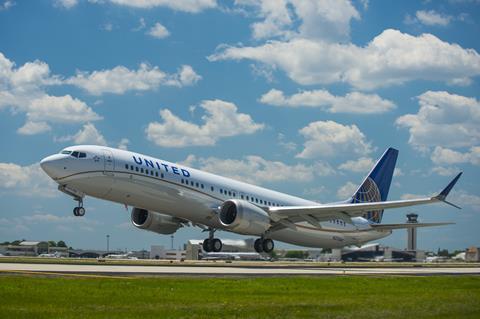United Airlines anticipates returning two Boeing aircraft types to its schedule after dealing with separate safety issues that grounded both this year.
More than half of United’s Boeing 737 Max aircraft – 17 of 30 – are affected by an electrical issue that the airframer identified earlier this month, but the fix is uncomplicated, the Chicago-based carrier says on 20 April.
Two weeks ago, Boeing urged 16 operators of the jet type – including American Airlines, Southwest Airlines and United – to address an electrical concern before further operating the aircraft.

“We have really good collaboration with Boeing and the FAA and the solution is relatively straightforward,” says Jon Roitman, United’s chief operations officer. “We have progress and… it should be a pretty short process.”
The FAA issued a brief statement on 9 April mentioning the Max’s back-up power control unit.
“Boeing notified the FAA late Thursday that it is recommending that operators of certain Boeing 737 Max airplanes temporarily remove them from service to address a manufacturing issue that could affect the operation of a back-up power control unit,” the FAA said at the time. “The FAA is in contact with the airlines and the manufacturer and will ensure the issue is addressed.”
Neither the FAA nor Boeing has provided more details about the control unit, or what it does.
The problem was another blow to the Max, which had been grounded for 20 months following two crashes in 2018 and 2019 that killed 346 people. The FAA re-certificated the aircraft in November 2020, and United returned its Max to service in February.
PRATT-POWERED 777-200s
Another Boeing type, 777-200s powered by Pratt & Whitney PW4000 turbofans, will require more in-depth checks and could take longer to return to the fleet.
Regulators grounded 777s with those engines in February following an in-flight engine explosion involving a United 777. The grounding prompted Japan Airlines to retire affected jets.
United, however, intends to return its 24 PW4000-powered 777s to service, though exactly when remains unclear.
“It’s too premature for us to outline what that timeline will look like,” Roitman says, citing “progress [and] good collaboration” with the Chicago-based airframer.
“We are really looking forward to getting that aircraft back in the air safely,” he adds.
The in-flight failure occurred on 20 February shortly after a United 777-200 took off from Denver, bound for Honolulu. The jet suffered a major engine failure, shedding debris over a residential area, including the engine’s nose cowl, which landed feet from a house. Parts of a severed fan blade landed on a soccer field.
The US National Transportation Safety Board (NTSB) has said the engine suffered metal fatigue.
The FAA ordered a grounding and issued an emergency airworthiness directive requiring US operators conduct thermal imaging inspections of fan blades. Each engine has 22 blades.
The incident came more than two months after a similar incident involving a JAL 777 flying from Okinawa’s Naha airport to Tokyo Haneda.






















